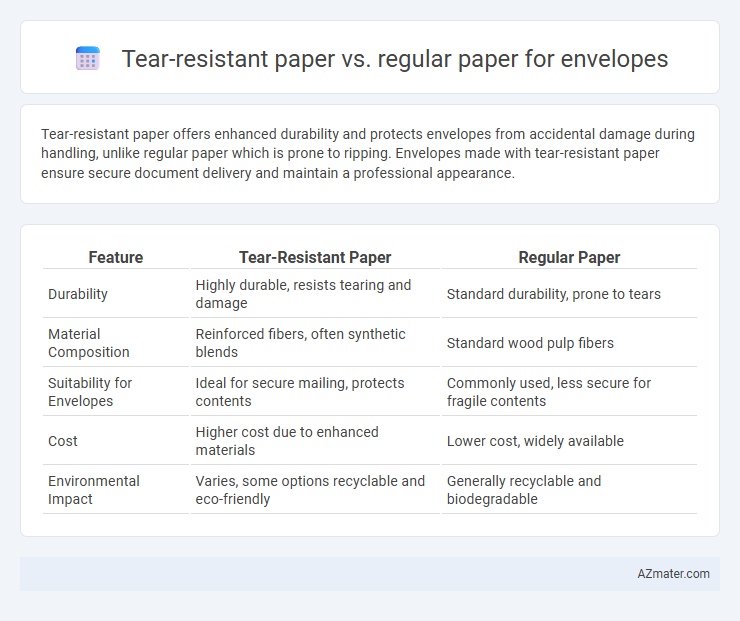Tear-resistant paper offers enhanced durability and protects envelopes from accidental damage during handling, unlike regular paper which is prone to ripping. Envelopes made with tear-resistant paper ensure secure document delivery and maintain a professional appearance.
Table of Comparison
| Feature | Tear-Resistant Paper | Regular Paper |
|---|---|---|
| Durability | Highly durable, resists tearing and damage | Standard durability, prone to tears |
| Material Composition | Reinforced fibers, often synthetic blends | Standard wood pulp fibers |
| Suitability for Envelopes | Ideal for secure mailing, protects contents | Commonly used, less secure for fragile contents |
| Cost | Higher cost due to enhanced materials | Lower cost, widely available |
| Environmental Impact | Varies, some options recyclable and eco-friendly | Generally recyclable and biodegradable |
Introduction to Tear-Resistant and Regular Paper
Tear-resistant paper, crafted with reinforced fibers and specialized coatings, offers enhanced durability for envelopes, preventing accidental tearing during handling and mailing. Regular paper used in envelopes typically consists of standard wood pulp fibers, providing basic strength but lacking enhanced resistance to ripping or damage. The choice between tear-resistant and regular paper impacts the envelope's ability to protect contents, especially during high-volume or rough transit conditions.
What is Tear-Resistant Paper?
Tear-resistant paper is specially engineered to withstand ripping and tearing, offering enhanced durability compared to regular paper used for envelopes. It incorporates synthetic fibers or coatings that reinforce the paper's structure, making it ideal for protecting sensitive documents during transit. Envelopes made from tear-resistant paper ensure secure handling and reduce the risk of damage or tampering, which is crucial for important mailings.
Properties of Regular Paper Used in Envelopes
Regular paper used in envelopes typically features moderate tensile strength and standard durability, making it suitable for everyday mailing needs. Its fiber composition allows for adequate ink absorption but lacks enhanced tear resistance, leading to higher susceptibility to ripping under stress. The smooth surface finish supports effective printing and addressing while maintaining cost-efficiency in mass production.
Durability Comparison: Tear-Resistant vs Regular Paper
Tear-resistant paper offers significantly higher durability than regular paper, making envelopes less prone to ripping during handling and mailing. Its reinforced fibers and special coatings enhance resistance to tears and punctures, ensuring contents remain secure. Regular paper envelopes are more susceptible to damage, especially under stress or rough handling, resulting in lower overall protection for mailed items.
Water and Weather Resistance
Tear-resistant paper provides superior water and weather resistance compared to regular paper, making it ideal for envelopes exposed to harsh environmental conditions. Its reinforced fibers prevent water absorption and damage from humidity, ensuring the contents remain dry and protected. Regular paper envelopes often lack this durability, making them prone to tearing and moisture damage during transit.
Security Benefits for Mailing Sensitive Documents
Tear-resistant paper offers superior security benefits for mailing sensitive documents by significantly reducing the risk of tampering or unauthorized access during transit. Its durable fibers and reinforced composition prevent easy tearing or puncturing, ensuring that confidential information remains protected from physical breaches. Unlike regular paper, which can be easily ripped or damaged, tear-resistant envelopes enhance document security by providing a tamper-evident barrier critical for legal, financial, and personal correspondence.
Environmental Impact and Recyclability
Tear-resistant paper for envelopes typically incorporates synthetic fibers or coatings that can hinder the recyclability process compared to regular paper, which is composed of natural fibers and is more easily recycled in standard paper mills. The environmental impact of tear-resistant paper is higher due to the energy-intensive production methods and potential contamination of recycling streams caused by non-biodegradable additives. Regular paper envelopes contribute to reduced environmental footprint by supporting circular economy initiatives, as they decompose more readily and are accepted by most recycling programs without special treatment.
Cost Effectiveness: Budget Considerations
Tear-resistant paper for envelopes offers enhanced durability, reducing damage during shipping, which can lower replacement costs despite its higher initial price compared to regular paper. Regular paper envelopes, while cheaper upfront, may incur additional expenses due to increased risk of tears and compromised contents, affecting long-term cost efficiency. Budget-conscious buyers should weigh the upfront investment of tear-resistant paper against potential savings from fewer damaged items and returns.
Use Cases: When to Choose Tear-Resistant Over Regular Paper
Tear-resistant paper is ideal for sending important documents, legal papers, or confidential information where durability and protection against tampering are crucial. Regular paper suits everyday mailing needs such as sending invitations, flyers, or lightweight correspondence that do not require extra strength. Choosing tear-resistant paper enhances security and longevity in transit, especially for sensitive or high-value contents.
Conclusion: Which Envelope Paper is Right for You?
Tear-resistant paper offers enhanced durability and protection against damage, making it ideal for important documents and secure mailings, whereas regular paper is more cost-effective and suitable for everyday correspondence. Choosing the right envelope paper depends on the level of security and handling your mail requires; for sensitive or valuable contents, tear-resistant paper is the better choice. For routine use and budget-friendly options, regular paper envelopes provide adequate performance without extra expense.

Infographic: Tear-resistant paper vs Regular paper for Envelope
 azmater.com
azmater.com